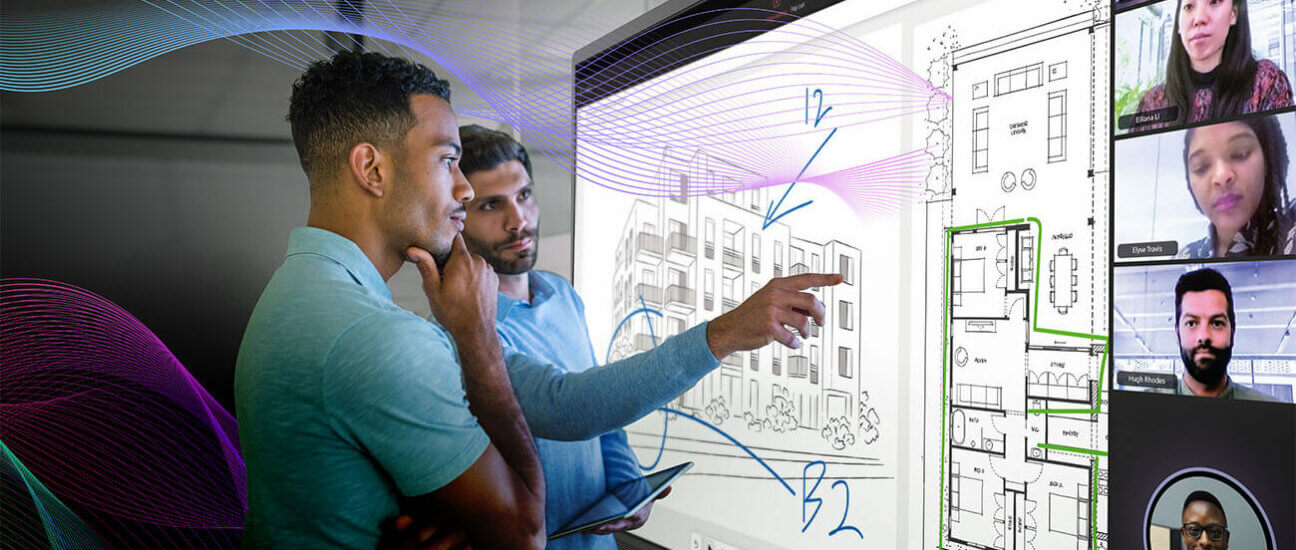Published on December 11th, 2023
Technology in the workplace: Benefits, best uses, and more
11 minute read

Technology’s ability to work faster and more efficiently while maintaining open communication among employees has become the standard. The added benefit of adaptive technologies cultivates a positive workplace culture.
Remote and hybrid work owes its existence to technology, opening new avenues for flexibility. Automation permits employees to channel their creativity and innovation, driving growth and increasing sales.
We eagerly embrace technology in this era, looking forward to the latest ideas to increase productivity, foster collaboration, and ignite creativity.

Benefits and impact of technology in the workplace
The once-distant dream of automating tasks is now a tangible reality in businesses and corporations worldwide. It benefits the bottom line and enhances the ability to manage responsibilities.
For example, employees work from diverse corners of the world, even the most remote locations, facilitated by technological devices. With a few clicks, employees can collaborate with colleagues and clients.
These technological advances have become instrumental in streamlining processes within businesses and global corporations, impacting day-to-day operations, client meetings, and recruitment practices. Let’s dive deeper into technology’s profound impact on the workplace and explore how companies and employees can leverage these advancements for mutual benefits.
Streamlined processes
Artificial intelligence (AI) paired with automation tools reduces the need for extensive managerial oversight. This allows for resource reallocation toward hiring individuals crucial for product or service development and growth.
Enhancing communication and collaboration
While handwritten notes and traditional letters belong to bygone eras, even phone calls can now seem disruptive and time-consuming. Technology improves communication, enabling rapid, efficient interactions among employees and clients. These technological advancements assist swift and meaningful conversations within optimal time frames.
Moreover, modern technologies foster employee collaboration, exchanging knowledge, skills, and resources.
Cultivating creativity and driving innovation
Companies embracing technology gain an edge over their competition. Business leaders position themselves at the forefront of their industry by dedicating time and resources to fueling creativity and pioneering inventive solutions.
Embracing workplace flexibility
Gone are the days when everybody needed to occupy the same building tethered to hard-wired computers linked by single landlines. Today’s workplace extends beyond the physical constraints of a specific building or location. Upgraded infrastructure and a plethora of cloud-based software grant employees access to all necessary tools, enabling them to operate in remote or hybrid environments.
This allows employees to take control of their work environment, promoting a greater sense of well-being and reducing absenteeism, mitigating stress levels, ultimately encouraging greater productivity and increased job satisfaction.
Accessing unprecedented amounts of information
The once-prized skill of conducting research in a standalone library guided solely by a card catalog is no longer a necessity. The evolution of technology has transformed access to a wealth of information, including archives dating back years, shaping the modern workplace.
Technological advancements are not only good for employees. Companies across all sectors can harness the benefits of technological tools that improve business functionality. These tools encourage connectivity among employees, stimulating innovation within an adaptable work environment.
What types of technology have recently changed the workplace?
Employees are no longer confined to an office. Advancements in technology such as power banks, multi-use cords, and hotspots have facilitated remote work, allowing tasks to be completed from virtually anywhere.
Additionally, VPNs and biometrics in network security handle the protection of sensitive data, regardless of the employees’ location.
Sophisticated video conferencing technologies have also empowered employees to connect, collaborate, and engage with each other, even while attending to personal engagements. The growing demand for a healthier work-life balance has been met by technological advancements, so we can embrace this change.
Cutting-edge technologies like AR/VR and AI have revolutionized learning methods, allowing personalized training at the convenience of each employee’s schedule. AI-driven automation alleviates employees from mundane tasks, redirecting company resources to more impactful areas. The rapid data analysis capabilities of AI empower business leaders to make informed decisions, reshaping the workplace and transforming the way we do business more than any other recent technology.
Hybrid workplace technology
During the pandemic, the transition to remote work surged as businesses aimed to protect their most valuable assets–their employees–from falling ill. Recently, businesses have requested employees return to work in some capacity, often proposing three days in the office and two days working from home. How does technology support this hybrid work model?
Platforms like Zoom, Google Meet, and Microsoft Teams offer video conferencing tools, allowing employees to stay connected whether they’re working in the office or from home on any given day of the week. Similarly, communication tools, including Slack, Microsoft Teams, and emails facilitate interaction among employees without relying on personal cell phones.
Additionally, project management software such as Monday, Asana, Trello, or Coda enables businesses to maintain order when assigning projects or tasks to employees. This reduces the need for extensive team meetings or requiring all staff to be physically present.
From there, suites like Google Workspace or Microsoft 365 provide a range of productivity and collaboration tools accessible from anywhere. Cloud-based tools offer an excellent means for employees to access the necessary resources to complete their work at home.
Assistive technology in the workplace
According to Congress, the term “assistive technology” means technology designed to be utilized in an assistive technology device or assistive technology service. Likewise, assistive technology devices encompass equipment or products utilized to aid individuals with disabilities.
With advancing technology, the range of possibilities appears limitless. Below are examples of types of assistive technologies that employees might find beneficial based on their specific disability.
Screen readers
The development of screen readers offered for free by companies like NVDA empowers individuals with visual impairments to engage with virtually any website. These software programs interact with websites by converting images to text and audibly interpreting all available content, including menus, buttons, and icons.
This accessibility feature is open source and ensures that all employees can access information from any device, promoting a positive workflow and environment.
Adaptive keyboards
Individuals with limited mobility need adaptive or customizable keyboards. These keyboards allow users to program keys, enhancing productivity by reducing task completion times.
They frequently provide multimedia control directly from the keyboard, eliminating the need for a trackpad or mouse. Furthermore, many of these keyboards offer ergonomic features to elevate user comfort.
Dictation software
Typing can be inefficient for some employees, particularly those facing challenges with hand and finger dexterity. Dictation software, like the free option available at dictation.io, enables users to “type” using their voice, eliminating the need for manual typing.
Additionally, many of these programs feature functions for composing paragraphs and adding punctuation.
Why should businesses adopt assistive technology?
Assistive technology in the workplace promotes independence and encourages communication. Inclusive training guarantees that all employees receive the necessary support and tools essential for their success.
It’s crucial for businesses to embrace such technology to sustain the mental health and well-being of their entire workforce.
ActivPanel 9 Pro is changing the landscape of technology in the workplace
Promethean’s ActivPanel 9 Pro paves the way for next-generation users. Boasting a 4K UHD display, it facilitates effortless collaboration among employees, fostering dynamic interactions and enhancing productivity in presentations and brainstorming sessions, regardless of their geographical location.
Additionally, the ActivPanel 9 Pro seamlessly connects with platforms like Google Suite and Microsoft Teams, so employees can easily adapt between working on a laptop at home or in the office. Employees can quickly open files and share their screen with team members, no matter where they are.
Equipped with a range of features, the ActivPanel 9 Pro can revolutionize the technology in the workplace, offering reliable connectivity, enhanced security measures, and user-friendly functionality. Its durable design is built to withstand the test of time with its integrated microphone array, flexible connection options, and improved viewing angles with its bonded glass.
The panel’s vellum touch technology delivers an exceptional intuitive experience, providing users with advanced features such as pen and finger differentiation, palm erase, advanced palm rejection, and 20-point touch. By transforming how employees interact regardless of location, the ActivPanel 9 Pro increases engagement and keeps teams focused on tasks, elevating the workplace.




